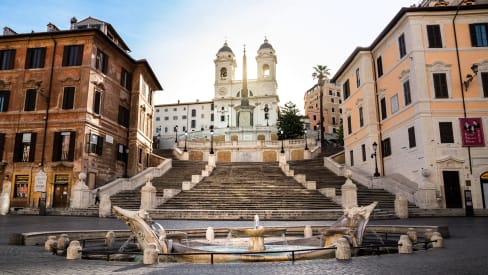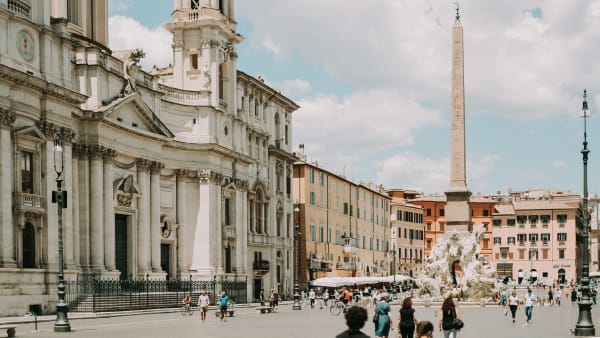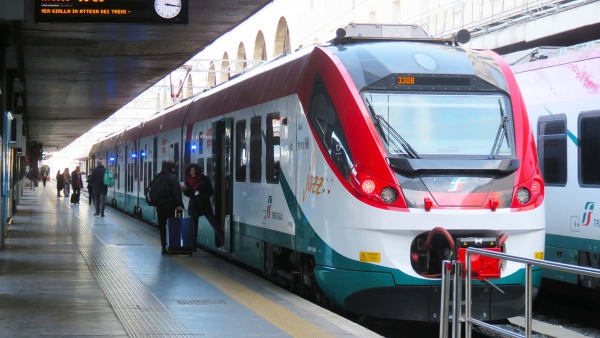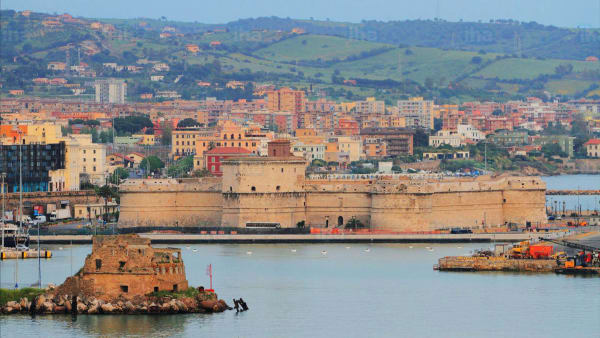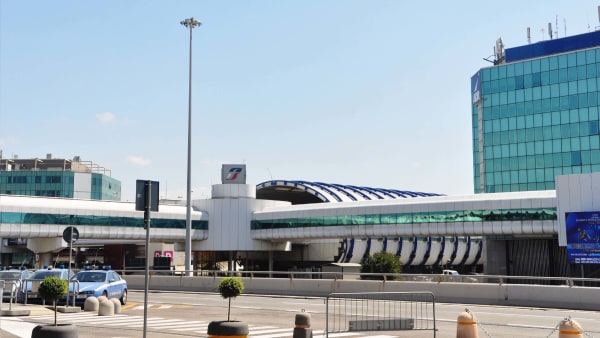Buildings and monuments
Buildings and monuments
As mentioned before, this place is full of magnificent buildings, monuments, and artwork from different times in the history of Rome. Some of the most relevant are referenced in the historical section of this article and will be now discussed more in-depth.
The Spanish Steps
The world-famous Steps (Scalinata di Trinità dei Monti, in Italian) that look down on the square are made up of 137 individual steps in travertine and decorated with commemorative stones. They were built between 1723 and 1726 by the Roman architect Francesco De Sanctis, as a scenographic junction for the slope of Pincio Hill.
The idea of connecting the two parts of this drop with steps dates back to 1559, but it was only in 1660 that the first projects were drawn up. What came up then was the controversy about the ownership of the land, between the Church and the French State. This is one of the reasons why works on the project did not start until later on.
In 1717 Pope Clement XI launched a contest for the project, to which the major architects of the time all participated, including De Sanctis. Due to the aforementioned controversy, it was only possible to start working on the Steps under Pope Innocent XIII. To this day, his heraldic symbols—the eagles of the Conti Noble House—are visible at the foot of the steps, alternating with the French lily. The work was finished under Benedict XIII, with a cost of over 50,000 scudi.
Decorated with garden terraces, the Steps alternates ramps and balconies. These elements part and reunite throughout the length of the steps, creating movement and a lively, varied scenery. This way, the construction is free from the usual regular structure of a series of steps, instead of integrating graciously with the surrounding space.
The sumptuous, noble structure was built with the intent of seeming more and more evocative as one got closer to it.
This was in fact a feature of Baroque-style architecture, where long and deep perspectives were preferred, perhaps ending with a monumental backdrop.
In 1728, due to the heavy rainfall that hit Rome, only two years after the end of the works, the Steps saw the collapse of the wall on the left-hand flank. Filippo Juvarra took care of the restoration work in 1731.
Since then, it has been used as a backdrop or set for films, events, and shows, becoming one of the most famous roman corners.
Since 1951, every year in April, there has been a floral exhibit taking place on the 137 steps. During the Christmas Holidays, it is possible to see the Presepe Pinelliano, a papier-mache nativity scene.
Trinità dei Monti Church
The Trinità dei Monti Church, overlooking the square with its two bell towers, was consecrated in 1594. Just like the adjacent convent, it owes its origin to Saint Francis of Paola. In 1494, Charles VIII, son of the King of France Luis XI, wanted to express his gratitude towards San Francis for the spiritual guidance he had offered to his father. Charles thus ordered the construction of the church on the Pincio Hill, with the intent of welcoming the French religious order of the Minims, founded by Francis of Paola.
The construction lasted for the entirety of the 16th century, and was then on considered the “Roman church of the French Kings”. It was initially designed in gothic style, with stones from the Narbonne region. It had only one nave, bordered by six chapels. Two transept chapels were added. It is believed that the two architects were Annibale Lippi and Gregorio Caronica.
Around 1774, the ancient main vault of the nave was modified, with a project by Giuseppe Pannini. The gothic structures were changed and the harmony in the ratio between the ogival cruise and the side chapels did too. A tall wrought iron gate was positioned in correspondence of the ogival cruise. It was supposed to preserve the traditional monastic life.
Trinità dei Monti Obelisk
In 1788 Pope Pius VI had the architect Antinori put up the Sallustiano Obelisk, the penultimate among the great obelisks placed in Rome. These were obelisks built at the time of the Roman Empire, in clear imitation of the Egyptian obelisks.
This one was built by Augustus and originally placed in the Circo Massimo, then transferred to Trinità dei Monti in 1789. The monument came from the Horti Sallustiani and might have been placed on the spina of the horse track. The original granite foundation was discovered in 1912 between Via Sicilia and Via Sardegna, and can now be found in the Campidoglio.
The Palace of Spain
As mentioned before, the square owes its name to the presence of the Spanish Embassy for the State of the Church. The building dates to 1647 and it is located on the south side of the square. The northern part, towards Via del Babuino, was originally called Piazza di Francia, due to the French ownership of the land and the church.
Spanish diplomats decided to renovate the palace in 1653 and employed Antonio del Grande to do so. He most likely used Borromini’s plans—the artist had been asked to collaborate on the project but couldn’t personally take part in the construction due to other commitments.
The facade was then embellished with two wooden balconies that grouped together five windows on the left and three on the right. However, the biggest changes happened inside. The new great hall now had archways held up by double columns, the great stairway was decorated with a banister with pillars, and the courtyard with an open gallery ornate with large windows and columns representing the Spanish Kings’ coat of arms.
Between 1685 and 1693 many changes were made to the facade, while the 1700s saw various decorations being made in the interior, as well as the construction of a private theatre.
After the short-lived French domination of Rome, which implied an occupation of the building by Napoleon’s army, there was a radical renovation of the facade, thanks to the Spanish architect Antonio Celles. He got rid of the balconies and the windows on the penultimate floor and substituted all the others.
Another alteration took place in 1857, following the Column’s blessing. For this ceremony, the facade was covered with a wooden structure that had a stage built in correspondence with the principal floor, from which the Pope could give his blessing. After the ceremony, the structure was taken down but two balconies for the side windows were built.
Another important change happened in 1898, with the decoration of the entrance stairway. Here, a marvelous fresco was placed, representing the “Delivery of the Keys of Granada”, by F. Ballester.
The last alteration was in 1932 when a central balcony connecting three windows on the main floor was built. The facade presents three arched doorways, connected by one rustic ashlar. Above these is the balcony. In total there are three floors, the main one having three loggias.
Column of the Immaculate Conception
Next to the square, there is a monument dedicated to the dogma of the Immaculate Virgin. It was established by Pope Pius IX in 1854, three years prior. The bronze statue of the Virgin Mary, by Giuseppe Obici, is located on the top of a cipollini marble column, almost 12 meters high, which rests on a base decorated by bas-reliefs.
It was found during the excavations of Campo Marzio, in 1778. The base is decorated by four statues in bronze, representing Moses, David, and the prophets Isaia and Ezekiel. The total height of the monument is 29 meters.
To put it up, on the 25th of December 1856, a fire brigade team had to intervene. 240 bishops and other prelates attended the ceremony. The Pope arrived on a chariot, followed by almost the entire Sacred College of Cardinals and the Apostolic Curia.
To this day, every year on the 8th of December, a team of firefighters, in the presence of the Pope, the Municipality, and State authorities, climb the height of the column on a ladder to place a flower crown on the highest point of the statue.
The Propaganda Fide Palace
The Palazzo di Propaganda Fide (Palace of the Propagation of the Faith), is a property under the jurisdiction of the Holy See. It hosted the Pontifical Urban College, an institution whose purpose was the education of Catholic missionaries and the management of their work around the world. From the start, it also served as headquarters for the Sacred Congregation for the Propagation of the Faith, and to this, it owes its name.
The structure was commissioned by Pope Urban VII to Gian Lorenzo Bernini, but it ended up being completed by Francesco Borromini, as requested by Pope Innocent X. In 1644, Bernini designed the facade overlooking the Spanish Square, highlighting the Pope’s coat of arms. The sculptor also added a chapel for Pope Urban VIII.
Some years later, Bernini completed the right-hand facade. In what was going to be his last project, the artist kept his characteristic style, with non-architectural curves, capitals, and such elements.
Inside the Palace, the pontiff ordered the construction of the Chapel of the Three Wise Men. However, Borromini destroyed it completely in order to rebuild it between 1662 and 1664. Cardinal Bernini was the one to request the subject to be the Wise Men. They symbolized the first pagans converted to Christianity, and thus a sign of recognition of the spiritual values promoted by the congregation.
The Palace, which then housed the ethnographic-missionary collection of the Borgia Museum (currently kept in the Vatican), can now be visited upon agreement. It now hosts a museum where several unpublished works are held. Among these, are the extraordinary paintings: Diluvio Universale (Great Flood) by Salvator Rosa, Romolo e Remo (Romulus and Remus) by Marco Tullio Montagna, Annunciazione (Annunciation) believed to have been made by Denijs Calvaert, and Pentecoste (Pentecost) by Corrado Giaquinto.
The Keats - Shelley House
To the sides of the church, there are two elegant buildings. On the right is the one called Casina Rossa (Little Red House), which belonged to a lady named Anna Angeletti, who used to rent rooms to tourists visiting Rome.
In 1820, English poet John Keats stayed here, in the house at the foot of the steps, with his friend and painter Joseph Servern. Keats, suffering from phthisis, was sent to Rome in the hopes that the climate would help his health recover. However, he died just a year after, depressed by the strong critiques of his writings and saddened by unrequited love.
After his death, the poet Percy Bysshe Shelley wrote his poem Adonais, and the following year died in a shipwreck in the Gulf of La Spezia. The artists are buried in the Protestant Cemetery of Rome. In 1906 the House was bought by an Anglo-American association. Today, it houses the museum, the Keats-Shelley Memorial House, inaugurated in 1909 in the presence of King Vittorio Emanuele III.
The museum also has a library, dedicated to the most renowned English Romantic poets. It holds about 8,000 books, as well as memorabilia and pictures which previously belonged to famous poets, like Byron. Keats’ room and place of comfort, facing the fountain, is nowadays almost a place of worship. The original furniture was however burned under the order of the Pope, and today we only have a few remains left.
Giorgio de Chirico House Museum
“They say that Rome is at the center of the world and that Piazza di Spagna is in the center of Rome, therefore, my wife and I would indeed be living in the center of the center of the world, which would be the apex of centrality and the apogee of anti-eccentricity”.
This eloquent and passionate statement was made by Giorgio de Chirico in his Memoirs, in 1945.
The artist arrived in Rome in 1944, after much traveling through European cities and a prolonged stay in New York. De Chirico finally settled in Rome in his Piazza di Spagna house in 1948, at the age of sixty. He spent the last thirty years of his life here, together with his second wife Isabella Pakszwer. She stayed here until 1990, the year of her death.
The flat is composed of the living quarters, the study, and a large balcony on the last of the three top floors belonging to the Palazzetto dei Borgognoni.
Thanks to Isabella’s will, the House Museum is today accessible to the public. Its inauguration was on the 20th of November 1998, on the twenty-year anniversary of the artist’s death. It offers a unique opportunity to admire de Chirico’s private and everyday world, as well as giving the visitors access to his artistic imagination, in a striking encounter between life and art.
The sumptuous rooms on the main floor show us the grandeur of 1600s-style halls with a great number of works. Some of these are framed in gold, red damask curtains, silver, wooden angels, marble coffee tables, and Louis XVI-style armchairs. This is the most vital part of the house, used for the reception of guests. The works here exposed by the Foundation aim to show the visitors the subjects and themes preferred by the artist.
Going up the stairs, visitors can see the more private and intimate rooms of the house, the bedroom, and the study. Surely, the latter is the most evocative space in the house. The easel and other craft objects are arranged in such a manner that suggests they might be used again any time now. Various plaster models representing ancient statues, gladiators, and horses are scattered throughout the artist’s personal library, also full of precious monographs.
A large terrace (limited access for the public) makes up the top floor of the house. Here de Chirico loved to ponder over the beauty of Rome and nature.
The Barcaccia Fountain
At the foot of the Spanish Steps, in the middle of the Spanish Square, we find the Barcaccia (the Bad Ship, in Italian), one of the most beautiful fountains in Rome. It is so-called because of its portrayal of a half-sunken ship, resting inside an oval basin, slightly under street level. The bow and stern are identical and much higher compared to the sides, which are just above the basin level.
In the middle of the ship, a short baluster holds up another smaller basin, which stands shorter than the bow and stern edges. Water flows from this basin and into the ship itself. Here, the water flows over the flared side edges of the ship, into the bigger basin, under the ship.
Water also flows from another six spots—three at the bow and three at the stern. Two of them are sun-shaped human faces, and the other four face outside the boat, resembling cannons. Apart from the suns, the other decorations are two pontifical coats of arms at the two external extremities of the ship. These decorations between the two cannons, display the crown and the bees, symbols of the Barberini family (the Pope at the time).
The Fountain was commissioned by Urbano VIII Barberini and built between 1626 and 1629 by Pietro Bernini, father of the more famous Gian Lorenzo. The Pope’s intention was that of completing an old project from 1570, that would have seen the construction of a fountain in each of the major squares of the city, after the restoration of the Acqua Vergine aqueduct.
To this day, it’s still possible to drink from this historical fountain, even if the monument saw several restorations throughout the centuries, often due to vandalism.
The first restoration started in 1993 and lasted until 1999. In 2007, a group of drunk tourists damaged the papal coat of arms with a screwdriver. In 2015, the Fountain was damaged by a group of Dutch football fans, visiting Rome to support their team, Feyenoord, in a Europa League match against A.S. Roma. The group damaged greatly the monument, stepping into the fountain and throwing bottles, trash, and smoke bombs. This led to a massive restoration in 2015.
The Villa Medici
Located in the Viale della Trinità dei Monti, in the Campo Marzio district, the land and the existing buildings were acquired by cardinal Ricci’s family from Montepulciano. The project for the construction was assigned to Annibale Lippi in 1544. The villa then went to the Medici family—where it takes its name—from them to the grand dukes of Tuscany and finally to the French State.
In 1803 Napoleon transferred here to the French Academy, originally located in the Salviati Palace. The academy was founded by Louis XIV in 1666 to allow young French painters to study in Rome. The institution still stands today.
In front of the Villa Medici, we can find the Vasca del Pincio (Pincio Hill basin): a simple fountain, with a huge basin and a cannonball in the middle. This has given the fountain the alternative name of Fountain of the Ball. This monument was also made by Annibale Lippi.


